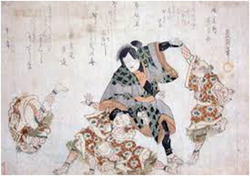A Brief History
Dave Boesel
Jujitsu is the hand-to-hand fighting art of the Samurai in Japan. It’s what a Samurai warrior used in combat when he lost his weapons. The origins of jujitsu are murky, but it is over one thousand years old. It wasn’t a unified martial art back then. Rather, there was a variety of fighting techniques and methods that Samurai were trained to use in combat in different parts of Japan to support the local lords (daimyo) to whom they were pledged. These close-in fighting techniques did not have a common name, but were referred to variously as “short sword grappling,” “grappling,” “softness,” “art of harmony,” etc. The “softness” referred to (the “ju” of jujitsu) did not imply weakness. It implied flexibility and resilience – momentarily yielding to an opponent’s force in order to turn the tables on him and defeat him. A classical analogy is a willow tree weighed down by snow. Its branches are bent down but not broken, and when the snow melts, they spring up again with force.
Until about the year 1600, the Samurai were usually occupied with fighting each other on behalf of their ambitious daimyo. However, at that time one top predator – the most powerful daimyo – emerged and pacified Japan by force of arms. His name was Tokugawa Ieyasu, and he founded the Tokugawa Shogunate, which was to last for 250 years. (The shoguns were military rulers of the country, something like generalissimos in Latin America.) During this period of enforced peace, the Samurai had no wars to fight – in effect, they were out-of-work warriors. Some turned to administration, others to the arts, and some to banditry, but many started martial arts schools – usually clan-based – wherein they could transmit their skills to younger generations. It was during this time that the various fighting techniques took on the name of jujitsu and began to form a unified martial art. (It wasn’t entirely unified, because each clan thought it had its own “secret” methods, but it turned out later that they held a large body of techniques in common.)
The Fighting Techniques
Jujitsu is a comprehensive martial art – that is, it encompasses almost all types of hand-to-hand fighting techniques. It is best known for its standing throws – especially over-the-shoulder hip throws – but it also includes striking and kicking; leg trips and sweeps; arm and hand techniques such as arm-bars; sacrifice throws, where the thrower drops first to bring his opponent down; ground wrestling; and submission techniques such as chokes and joint locks.
As a compendium of hand-to-hand fighting techniques, Japanese jujitsu has given rise to other related martial arts and is known as a parent art. Judo is a subset of jujitsu techniques selected and highly developed by Jigoro Kano in the late 19th century. Kano removed many of the dangerous elements from jujitsu to form an art that would be safe for students to learn, including even those in elementary schools. In the early 20th century, Morihei Ueshiba developed Aikido, a defensive martial art derived from jujitsu and emphasizing large flowing throws and arm and hand manipulation. Brazilian Jujitsu, developed by the Gracies in the early-to mid-twentieth century, comes out of Japanese jujitsu and judo. It emphasizes the development of skill in ground wrestling and submissions. Each one of these arts has further developed and refined certain Japanese jujitsu techniques. Instructors in Kaiwan Budokai are also ranked in each of these other arts, and we include some of their methods in our practice.
